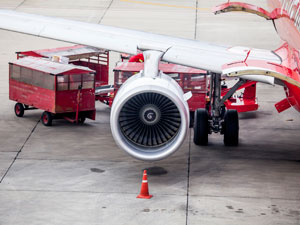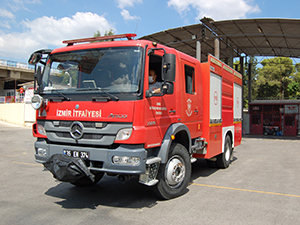Air Cargo Recovery Continues in June but at a Slow Pace
The International Air Transport Association (IATA) released data for global air freight markets in June showing improvement, but at a slower pace than some of the traditional leading indicators would suggest.

28 Temmuz 2020 Salı 20:05
- Global demand, measured in cargo tonne-kilometers (CTKs*), fell by 17.6% in June (-19.9% for international operations) compared to the previous year. That is a modest improvement from the 20.1% year-on-year drop recorded in May.
- Global capacity, measured in available cargo tonne-kilometers (ACTKs), shrank by 34.1% in June ( 33.9% for international operations) compared to the previous year. This was on par with the 34.8% year-on-year drop in May.
- Belly capacity for international air cargo shrank by 70% in June compared to the previous year due to the withdrawal of passenger services amid COVID-19. This was partially offset by a 32% increase in capacity through expanded use of freighter aircraft.
- Global manufacturing demand stabilized in June:
- The new export orders component of the Purchasing Managers Index (PMI) rose by 11 points compared to May, the strongest monthly increase since the series began in 1999.
- The PMI tracking global manufacturing output rebounded in June to its highest level since January.
“Cargo is, by far, healthier than the passenger markets but doing business remains exceptionally challenging. While economic activity is re-starting after major lockdown disruptions there has not been a major boost in demand. The rush to get personal protective equipment (PPE) to market has subsided as supply chains regularized, enabling shippers to use cheaper sea and rail options. And the capacity crunch continues because passenger operations are recovering very slowly,” said Alexandre de Juniac, IATA's Director General and CEO.
| |||||||||||||||||||||||||||||||||||||||||||||||||
1 % of industry CTKs in 2019 2 Year-on-year change in load factor 3 Load factor level | |||||||||||||||||||||||||||||||||||||||||||||||||
June Regional Performance
All regions recorded declines in June. Airlines in Europe and Latin America suffered the sharpest drops in year-on-year growth in total air freight volumes, while airlines in Asia-Pacific and the Middle East experienced slightly less dramatic declines. Airlines in North America and Africa saw more moderate drops compared to the other regions.
Asia-Pacific airlines saw demand for international air cargo fall by 20% in June 2020 compared to the same period a year earlier. This was a slight deterioration over the 18.8% drop in May. Despite manufacturing starting to pick up in the region, demand was impacted by the reduction in shipments of PPE by air. International capacity decreased 32.3%.
North American carriers reported a single digit fall in international cargo demand of 8.8% year-on-year in June. This was the smallest contraction of all regions. The resilient performance is due to the large freighter fleets of a few of the region’s airlines as well as the fiscal support to airlines in the USA from the CARES Act. International capacity decreased 30.7%.
European carriers reported a 27.6% annual drop in international cargo volumes in June. This was a slight improvement from May’s performance of -29.5% but still the second weakest performance of all regions. International capacity decreased 40.7%
Middle Eastern carriers reported a decline of 19.1% year-on-year in June, an improvement from the 24.9% fall in May. International capacity decreased 25.8%, the best of all regions. This was driven by the aggressive operational strategies of some of the region’s carriers.
Latin American carriers posted a 29.4% drop in year-on-year international demand in June. This was the weakest performance of all regions. International capacity decreased 43.6% indicating a sizeable capacity crunch. The COVID-19 crisis is particularly challenging at present for airlines based in Latin America owing to strict lockdown measures.
African airlines posted a contraction of 13.8% in June. This was a weaker performance than the 7.3% fall in demand in May. The small Africa-Asia market continued to grow in June up 20.1%. However, the region suffered from the effects of the pandemic becoming more severe in June. International capacity in this region decreased 46.2%.
![2025 Atlas Lojistik Ödülleri’ni Kazananlar Ne Dediler? - Melike Batur]() 2025 Atlas Lojistik Ödülleri’ni Kazananlar Ne Dediler? - Melike Batur2025 Atlas Lojistik Ödülleri yarışmasında “En Beğenilen Depo Yöneticisi (Online Oylama)” ödülünü alan Melike Batur’un tören sonrasında kameralarımıza yaptığı açıklamaları ekranlarınıza getiriyoruz.12 Aralık 2025 Cuma 13:15Lojistik
2025 Atlas Lojistik Ödülleri’ni Kazananlar Ne Dediler? - Melike Batur2025 Atlas Lojistik Ödülleri yarışmasında “En Beğenilen Depo Yöneticisi (Online Oylama)” ödülünü alan Melike Batur’un tören sonrasında kameralarımıza yaptığı açıklamaları ekranlarınıza getiriyoruz.12 Aralık 2025 Cuma 13:15Lojistik![Mercedes-Benz Türk Kayseri’de Heska ile Hizmet Ağını Genişletti]() Mercedes-Benz Türk Kayseri’de Heska ile Hizmet Ağını GenişlettiMercedes-Benz Türk, Heska Kayseri bayisini hizmete açarak bölgede satış ve servis ağını güçlendirdi.11 Aralık 2025 Perşembe 16:59Ticari Araçlar
Mercedes-Benz Türk Kayseri’de Heska ile Hizmet Ağını GenişlettiMercedes-Benz Türk, Heska Kayseri bayisini hizmete açarak bölgede satış ve servis ağını güçlendirdi.11 Aralık 2025 Perşembe 16:59Ticari Araçlar![2025 Atlas Lojistik Ödülleri’ni Kazananlar Ne Dediler? - BASF Türk]() 2025 Atlas Lojistik Ödülleri’ni Kazananlar Ne Dediler? - BASF TürkBASF Türkiye ve Orta Doğu, Gümrük ve Dış Ticaret Müdürü Güler Polat’ın Atlas Lojistik Ödülleri töreninde yaptığı açıklamaları ekranlarınıza getiriyoruz.11 Aralık 2025 Perşembe 15:37Ticari Araçlar
2025 Atlas Lojistik Ödülleri’ni Kazananlar Ne Dediler? - BASF TürkBASF Türkiye ve Orta Doğu, Gümrük ve Dış Ticaret Müdürü Güler Polat’ın Atlas Lojistik Ödülleri töreninde yaptığı açıklamaları ekranlarınıza getiriyoruz.11 Aralık 2025 Perşembe 15:37Ticari Araçlar![DP World Evyap Konteyner Elleçlemede 1 Milyon TEU Seviyesine Ulaştı]() DP World Evyap Konteyner Elleçlemede 1 Milyon TEU Seviyesine UlaştıDP World Evyap, 2025’te bir milyon TEU konteyner elleçleme eşiğini aşarak Türkiye’nin lojistik kapasitesindeki dönüşümün öncüsü oldu. İleri teknoloji yatırımlarıyla güçlenen terminal, bölgesel ticarette yeni bir büyüme döneminin kapılarını aralıyor.11 Aralık 2025 Perşembe 10:03Denizcilik
DP World Evyap Konteyner Elleçlemede 1 Milyon TEU Seviyesine UlaştıDP World Evyap, 2025’te bir milyon TEU konteyner elleçleme eşiğini aşarak Türkiye’nin lojistik kapasitesindeki dönüşümün öncüsü oldu. İleri teknoloji yatırımlarıyla güçlenen terminal, bölgesel ticarette yeni bir büyüme döneminin kapılarını aralıyor.11 Aralık 2025 Perşembe 10:03Denizcilik![Shell & Turcas Filoları Geleceğe Taşıyan Çözümlerini logitrans 2025’te Tanıttı]() Shell & Turcas Filoları Geleceğe Taşıyan Çözümlerini logitrans 2025’te Tanıttı“İşi için yolda olan insanların Shell’i” mottosuyla faaliyetlerini sürdüren Shell Filo Çözümleri, lojistik sektörünün en önemli buluşmalarından Uluslararası logitrans Transport Lojistik Fuarı’nda yerini aldı.10 Aralık 2025 Çarşamba 16:44Lojistik
Shell & Turcas Filoları Geleceğe Taşıyan Çözümlerini logitrans 2025’te Tanıttı“İşi için yolda olan insanların Shell’i” mottosuyla faaliyetlerini sürdüren Shell Filo Çözümleri, lojistik sektörünün en önemli buluşmalarından Uluslararası logitrans Transport Lojistik Fuarı’nda yerini aldı.10 Aralık 2025 Çarşamba 16:44Lojistik![Yerli Üretim Peugeot Expert Traveller Yollara Çıkıyor]() Yerli Üretim Peugeot Expert Traveller Yollara ÇıkıyorBursa’daki Tofaş tesisinde üretimi başlayan Expert Traveller, güçlü donanımı ve 2.2 BlueHDi motoruyla Türkiye yollarına çıkmaya hazırlanıyor.10 Aralık 2025 Çarşamba 13:56Ticari Araçlar
Yerli Üretim Peugeot Expert Traveller Yollara ÇıkıyorBursa’daki Tofaş tesisinde üretimi başlayan Expert Traveller, güçlü donanımı ve 2.2 BlueHDi motoruyla Türkiye yollarına çıkmaya hazırlanıyor.10 Aralık 2025 Çarşamba 13:56Ticari Araçlar![Samsun Büyükşehir Acil Sağlık Filosu Volkswagen Crafter ile Güçlendi]() Samsun Büyükşehir Acil Sağlık Filosu Volkswagen Crafter ile GüçlendiSamsun Büyükşehir Belediyesi, 100 ambulans ve 5 hasta nakil aracı olmak üzere toplam 105 adet Volkswagen Crafter aracı filosuna dahil ederek şehrin acil sağlık hizmetlerinde kapasite artışı sağladı.09 Aralık 2025 Salı 16:55Ticari Araçlar
Samsun Büyükşehir Acil Sağlık Filosu Volkswagen Crafter ile GüçlendiSamsun Büyükşehir Belediyesi, 100 ambulans ve 5 hasta nakil aracı olmak üzere toplam 105 adet Volkswagen Crafter aracı filosuna dahil ederek şehrin acil sağlık hizmetlerinde kapasite artışı sağladı.09 Aralık 2025 Salı 16:55Ticari Araçlar![İzmir İtfaiyesi Hızlı Müdahalede Tam Otomatiği Tercih Ediyor]() İzmir İtfaiyesi Hızlı Müdahalede Tam Otomatiği Tercih Ediyorİzmir Büyükşehir Belediyesi İtfaiye Dairesi Başkanlığı araç filosunda bulunan Allison 3000™serisi tam otomatik şanzıman donanımlı kamyonlar, yangın ve acil durum mahallerine hızlı ve güvenilir erişimi destekliyor.09 Aralık 2025 Salı 16:39Ticari Araçlar
İzmir İtfaiyesi Hızlı Müdahalede Tam Otomatiği Tercih Ediyorİzmir Büyükşehir Belediyesi İtfaiye Dairesi Başkanlığı araç filosunda bulunan Allison 3000™serisi tam otomatik şanzıman donanımlı kamyonlar, yangın ve acil durum mahallerine hızlı ve güvenilir erişimi destekliyor.09 Aralık 2025 Salı 16:39Ticari Araçlar![Sürat Lojistik Avrupa Yapılanmasına Hazırlanıyor]() Sürat Lojistik Avrupa Yapılanmasına HazırlanıyorYurt içinde kısa sürede güçlü bir büyüme yakalayan Sürat Lojistik, yurt dışında doğrudan yapılanma hedefiyle Doğu Avrupa’ya odaklanıyor. Şirket, Polonya ve Romanya’yı Avrupa’daki ilk operasyonel adım olarak konumlandırıyor.09 Aralık 2025 Salı 16:05Lojistik
Sürat Lojistik Avrupa Yapılanmasına HazırlanıyorYurt içinde kısa sürede güçlü bir büyüme yakalayan Sürat Lojistik, yurt dışında doğrudan yapılanma hedefiyle Doğu Avrupa’ya odaklanıyor. Şirket, Polonya ve Romanya’yı Avrupa’daki ilk operasyonel adım olarak konumlandırıyor.09 Aralık 2025 Salı 16:05Lojistik![IATA Hava Kargodaki Büyümenin Devam Edeceğini ve 2026’da Gelirlerin 158 Milyar Dolar Olacağını Öngörüyor]() IATA Hava Kargodaki Büyümenin Devam Edeceğini ve 2026’da Gelirlerin 158 Milyar Dolar Olacağını ÖngörüyorUluslararası Hava Taşımacılığı Birliği (IATA), tedarik zinciri sorunları sürerken küresel havayolu endüstrisinin kârlılığının dengelendiğini gösteren en son finansal görünümünü ve 2026 öngörülerini yayımladı.09 Aralık 2025 Salı 14:59Havayolu
IATA Hava Kargodaki Büyümenin Devam Edeceğini ve 2026’da Gelirlerin 158 Milyar Dolar Olacağını ÖngörüyorUluslararası Hava Taşımacılığı Birliği (IATA), tedarik zinciri sorunları sürerken küresel havayolu endüstrisinin kârlılığının dengelendiğini gösteren en son finansal görünümünü ve 2026 öngörülerini yayımladı.09 Aralık 2025 Salı 14:59Havayolu
- Geri
- Ana Sayfa
- Normal Görünüm
- © 2025 Kargo Haber


















Türkçe karakter kullanılmayan ve büyük harflerle yazılmış yorumlar onaylanmamaktadır.